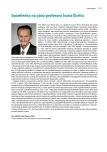-
Medical journals
- Career
Diagnostics of polycystic ovary syndrome
Authors: Ivica Lazúrová; Jana Figurová; Zora Lazúrová
Authors‘ workplace: I. interná klinika LF UPJŠ a UN L. Pasteura Košice, Slovenská republika, prednostka prof. MUDr. Ivica Lazúrová, DrSc., FRCP
Published in: Vnitř Lék 2015; 61(Suppl 5): 40-44
Category: Reviews
Overview
Polycystic ovary syndrome (PCOS) is the most frequent endocrinopathy among women of reproductive age and the most frequent cause of menstruation cycle disorders. It is marked by a hyperandrogenic state (clinical and/or biochemical) and ovulatory dysfunction (anovulation and/or ultrasonographic finding of polycystic ovaries), which are also criteria for its diagnosis according to Androgen Excess and PCOS Society. The syndrome has multiple phenotypic expressions, among them besides the above characteristics also a metabolic syndrome, primarily obesity and insulin resistance. Diagnosing of PCOS may be rather exacting in clinical practice and it remains to be a diagnosis per exclusionem, following elimination of other causes of hyperandrogenic state and chronic oligo-anovulation. It requires a close cooperation between a gynecologist and endocrinologist and with regard to frequent metabolic complications also with an internist, diabetologist and possibly cardiologist.
Key words:
AES criteria – diagnosis – differential diagnosis – polycystic ovary syndrome
Sources
1. March WA, Moor VM, Wilson KJ et al. The prevalence of polycystic ovary syndrome in a community sample assessed under contrasting diagnostic criteria. Hum Reprod 2010; 25(2): 544–551.
2. Alexander CJ, Tangchitnob EP, Lepor NE. Polycystic ovary syndrome: a major unrecognized cardiovascular risk factor in women. Rev Obstet Gynecol 2009 Fall; 2(4): 232–239.
3. Cussons AJ, Stuckey BG, Walsh JP et al. Polycystic ovarian syndrome: marked differences between endocrinologists and gynaecologists in diagnosis and management. Clin Endocrinol (Oxf) 2005; 62(3): 289–295.
4. Azziz R, Carmina E, Dewailly D et al. The Androgen Excess and PCOS Society criteria for polycystic ovary syndrome: the complete task force report. Fertil Steril 2009; 91(2): 456–488.
5. Alvarez-Blasco F, Botella-Carretero JI, San Millan JL et al. Prevalence and characteristics of the polycystic ovary syndrome in overweight and obese women. Arch Intern Med 2006; 166(19): 2081–2086.
6. Yildiz BO, Bozdag G, Yapici Z et al. Prevalence, phenotype and cardiometabolic risk of polycystic ovary syndrome under different diagnostic criteria. Hum Reprod 2012; 27(10): 3067–3073.
7. Conway G, Dewailly D, Diamanti-Kandarakis E et al. The polycystic ovary syndrome: a position statement from the European Society of Endocrinology. Eur J Endocrinol 2014; 171(1): 1–29.
8. Cibula D, Hill M, Starka L et al. The best correlation of the new index of hyperandrogenism with the grade of increased hair. Eur J Endocrinol 2000; 143(3): 405–408.
9. Yildiz BO, Boulour S, Woods K et al. Visually scoring hirsutism. Hum Reprod Update 2010; 16(1): 51–64.
10. Cibula D, Hill M, Vohradnikova O et al. The role of androgens in determining acne severity in adult women. Br J Dermatol 2000; 143(2): 399–404.
11. Haciveliglou S, Gungor AN, Gencer M et al. Acne severity and the Global Acne Grading system in polycystic ovary syndrome. Int J Gynaecol Obstet 2013; 123(1): 33–36.
12. Azziz R, Woods KS, Reyna R et al. The prevalence and features of the polycystic ovary syndrome in an unselected population. J Clin Endocrinol Metab 2004; 89(6): 2745–2749.
13. Strowitzki T, Capp E, Von Eye Corleta H. The degree of cycle irregularity correlates with the grade of endocrine and metabolic disorders in PCOS patients. Eur J Gynecol Reprod Biol 2010; 149(2): 178–181.
14. Sanchez LA, Perez M, Centeno I et al. Determining the time androgens and sex hormone binding globulin take to return to baseline after discontinuation of oral contraceptives in women with polycystic ovary syndrome: a prospective study. Fertil Steril 2007; 87(3): 712–714.
15. Dewailly D, Lujan ME, Carmina E et al. Definition and significance of polycystic ovarian morphology: a task force report from the Androgen Excess and Polycystic Ovary Syndrome Society. Hum Reprod Update 2014; 20(3): 334–352.
16. Jonard S, Robert Y, Cortet-Rudelli C et al. Ultrasound examination of polycystic ovaries: is it worth counting the follicles? Hum Reprod 2003; 18(3): 598–603.
17. Laven JS, Imani B, Eijkemans MJ et al. New approaches to PCOS and other forms of anovulatory infertility. Obstet Gynecol Surv 2002; 57(11): 755–767.
18. Homburg R, Crawford G. The role of AMH in anovulation associated with polycystic ovary syndrome: a hypothesis. Hum Reprod 2014; 29(6): 1117–1121.
19. Casadei L, Madrigale A, Puca F et al. The role of serum anti-Müllerian hormone (AMH) in the hormonal diagnosis of polycystic ovary syndrome. Gynecol Endocrinol 2013; 29(6): 545–550.
20. Livadas S, Diamanti-Kandarakis E. Polycystic ovary syndrome: Definition, Phenotypes and Diagnostic Approach. In: Macut D, Pfeifer M, Yildiz BO et al. Polycystic ovary syndrome. Novel Insights into Causes and Therapy: 40. Karger; Basel 2012 : 1–21. ISBN 978–3318022384.
Labels
Diabetology Endocrinology Internal medicine
Article was published inInternal Medicine

2015 Issue Suppl 5-
All articles in this issue
- Epidemiologic data of hyperuricaemia prevalence in the conditions of primary care in Slovakia
- Management of treatment in patients with neuroendocrine neoplasmas of digestive tract
- Specifics of using ambulatory blood pressure monitoring in the elderly
- Arterial hypertension – multicirculus vitiosus vasorum
- Hormonal changes in inflammatory bowel disease
- Diagnostics of polycystic ovary syndrome
- Non usual cases of hypoglycaemia – hypoglycaemia factitia
- Is iron important in heart failure?
- Novel diagnostic and therapeutic procedures in diabetic nephropathy
- Are we to pay attention to factor XII deficiency?
- Internal Medicine
- Journal archive
- Current issue
- Online only
- About the journal
Most read in this issue- Are we to pay attention to factor XII deficiency?
- Diagnostics of polycystic ovary syndrome
- Arterial hypertension – multicirculus vitiosus vasorum
- Hormonal changes in inflammatory bowel disease
Login#ADS_BOTTOM_SCRIPTS#Forgotten passwordEnter the email address that you registered with. We will send you instructions on how to set a new password.
- Career

